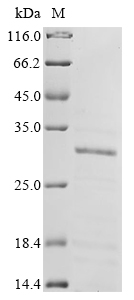Recombinant Human Polyadenylate-binding protein 2 (PABPN1)
CAT:
399-CSB-BP768207HU-01
Size:
1 mg
Price:
Ask
- Availability: 24/48H Stock Items & 2 to 6 Weeks non Stock Items.
- Dry Ice Shipment: No




Recombinant Human Polyadenylate-binding protein 2 (PABPN1)
- CAS Number: 9000-83-3
- Gene Name: PABPN1
- UniProt: Q86U42
- Expression Region: 2-306aa
- Organism: Homo sapiens
- Target Sequence: AAAAAAAAAAGAAGGRGSGPGRRRHLVPGAGGEAGEGAPGGAGDYGNGLESEELEPEELLLEPEPEPEPEEEPPRPRAPPGAPGPGPGSGAPGSQEEEEEPGLVEGDPGDGAIEDPELEAIKARVREMEEEAEKLKELQNEVEKQMNMSPPPGNAGPVIMSIEEKMEADARSIYVGNVDYGATAEELEAHFHGCGSVNRVTILCDKFSGHPKGFAYIEFSDKESVRTSLALDESLFRGRQIKVIPKRTNRPGISTTDRGFPRARYRARTTNYNSSRSRFYSGFNSRPRGRVYRGRARATSWYSPY
- Tag: N-terminal 10xHis-tagged
- Source: Baculovirus
- Field of Research: Epigenetics and Nuclear Signaling
- Assay Type: Developed Protein
- Relevance: Involved in the 3'-end formation of mRNA precursors (pre-mRNA) by the addition of a poly (A) tail of 200-250 nt to the upstream cleavage product. Stimulates poly (A) polymerase (PAPOLA) conferring processivity on the poly (A) tail elongation reaction and controls also the poly (A) tail length. Increases the affinity of poly (A) polymerase for RNA. Is also present at various stages of mRNA metabolism including nucleocytoplasmic trafficking and nonsense-mediated decay (NMD) of mRNA. Cooperates with SKIP to synergistically activate E-box-mediated transcription through MYOD1 and may regulate the expression of muscle-specific genes . Binds to poly (A) and to poly (G) with high affinity. May protect the poly (A) tail from degradation. Subunit of the trimeric poly (A) tail exosome targeting (PAXT) complex, a complex that directs a subset of long and polyadenylated poly (A) RNAs for exosomal degradation. The RNA exosome is fundamental for the degradation of RNA in eukaryotic nuclei. Substrate targeting is facilitated by its cofactor MTREX, which links to RNA-binding protein adapters .
- Purity: Greater than 85% as determined by SDS-PAGE.
- Activity: Not Test
- Length: Full Length of Mature Protein
- Form: Liquid or Lyophilized powder
- Buffer: If the delivery form is liquid, the default storage buffer is Tris/PBS-based buffer, 5%-50% glycerol. If the delivery form is lyophilized powder, the buffer before lyophilization is Tris/PBS-based buffer, 6% Trehalose, pH 8.0.
- Reconstitution: We recommend that this vial be briefly centrifuged prior to opening to bring the contents to the bottom. Please reconstitute protein in deionized sterile water to a concentration of 0.1-1.0 mg/mL.We recommend to add 5-50% of glycerol (final concentration) and aliquot for long-term storage at -20℃/-80℃. Our default final concentration of glycerol is 50%. Customers could use it as reference.
- Molecular Weight: 35.1 kDa
- References & Citations: "Identification of a nuclear exosome decay pathway for processed transcripts." Meola N., Domanski M., Karadoulama E., Chen Y., Gentil C., Pultz D., Vitting-Seerup K., Lykke-Andersen S., Andersen J.S., Sandelin A., Jensen T.H. Mol. Cell 64:520-533 (2016)
- Storage Conditions: The shelf life is related to many factors, storage state, buffer ingredients, storage temperature and the stability of the protein itself. Generally, the shelf life of liquid form is 6 months at -20℃/-80℃. The shelf life of lyophilized form is 12 months at -20℃/-80℃.
